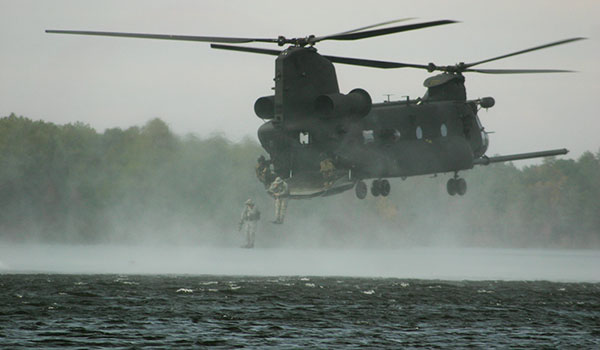
ARSOAC Commander Update / By BG Erik C. Peterson: Thank-you once again to AAAA and our Aviation Branch leadership for the opportunity to share some thoughts and perspectives from the Army Special Operations Aviation team.

An MH-47G conducts helocast operations for Special Forces Soldiers. / U.S. ARMY SPECIAL OPERATIONS AVIATION COMMAND PHOTO
I’ll begin by enthusiastically welcoming our relatively new Aviation Branch leadership – MG Bill Gayler, CW5 Joe Roland, and CSM Greg Chambers – and reaffirming the Army Special Operations Aviation Command’s (ARSOAC) commitment as an active partner in the Army Aviation enterprise – contributing to readiness, providing vital capabilities, developing leaders, caring for Soldiers and families, and promoting interoperability and interdependence – while relentlessly supporting our maneuver commanders.
As you read this issue of AAAA magazine Army Special Operations Aviation (ARSOA) Soldiers are deployed in five countries engaged in sustained combat and contingency operations, training with allies and partners in three OCONUS locations, building partner nation rotary-wing aviation capability in an additional three countries, engaged in multi-echelon training with Army and joint teammates throughout CONUS, and conducting rated and non-rated aircrew progression training at five CONUS locations to build the next generation of ARSOA Soldiers. Supporting and sustaining these operations are a high-performance team of maintainers, systems integrators, program managers, and industry partners – producing combat power in the form of exceptionally reliable, high-performance aircraft; modernizing the fleet in stride; and helping leverage technology to maintain the comparative advantage.
Concurrent with our ARSOA specific deployments and training we remain firmly engaged with the Army Aviation enterprise in efforts involving Future Vertical Lift, Improved Turbine Engine, Degraded Visual Environment, improved countermeasures and survivability, and improved weapons and lethality. We’re also continuing to invest in interoperability and interdependence with recent SOF-conventional teamed combat training center rotations, training exchanges, unmanned aerial system training, maintenance exchanges and training, intelligence forums, command and control working groups, and multi-compo partner nation capacity building initiatives.
Certainly a rigorous pace, sustained by magnificent leaders and Soldiers, and representative – a microcosm if you will – of our entire high-demand, relevant Army Aviation enterprise. As the past 15 years have certainly demonstrated, we do our best work – together – as a team.
As this summer progresses, the Army Special Operations Aviation Command and its units will also be in transition. Colonel Mike Hertzendorf completes two years of very successful command this summer and will hand the reins of the Night Stalkers over to Colonel Phil Ryan, a proven Night Stalker stalwart. The Army Special Operations Aviation Command (Airborne) will welcome Brigadier General John Evans Jr. as the new commanding general.
As I depart the ARSOAC to join the HQDA G3/5/7 DAMO-AV team, I’d like to offer sincere thanks to COL John Lindsay for his three years of exceptional leadership and teamwork as the Director of Army Aviation, and 28 years of distinguished Army service.
Above the Best
Volare Optimos
BG Erik Peterson
BG Erik C. Peterson is the commander of U.S. Army Special Operations Aviation Command located at Fort Bragg, NC.







